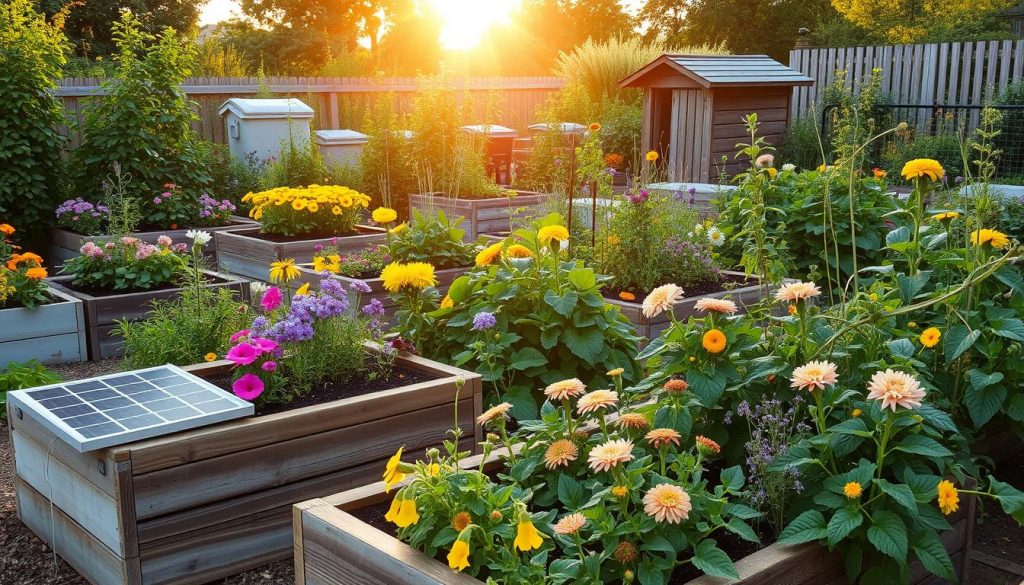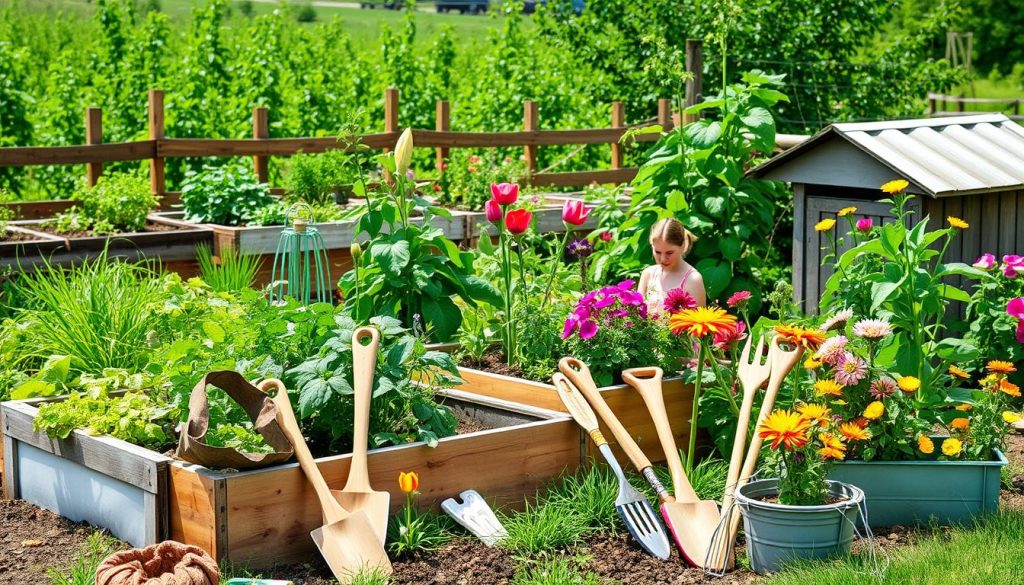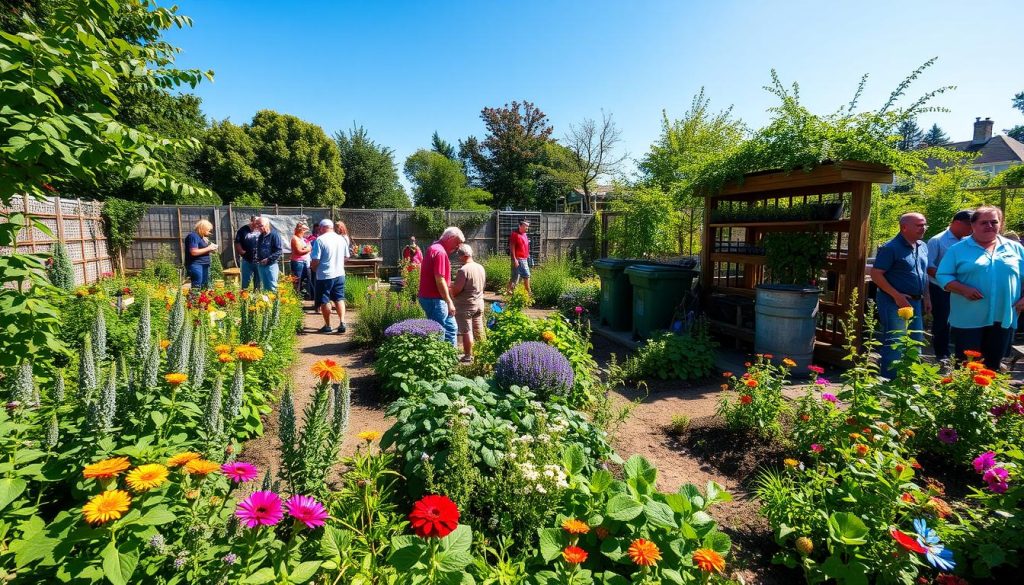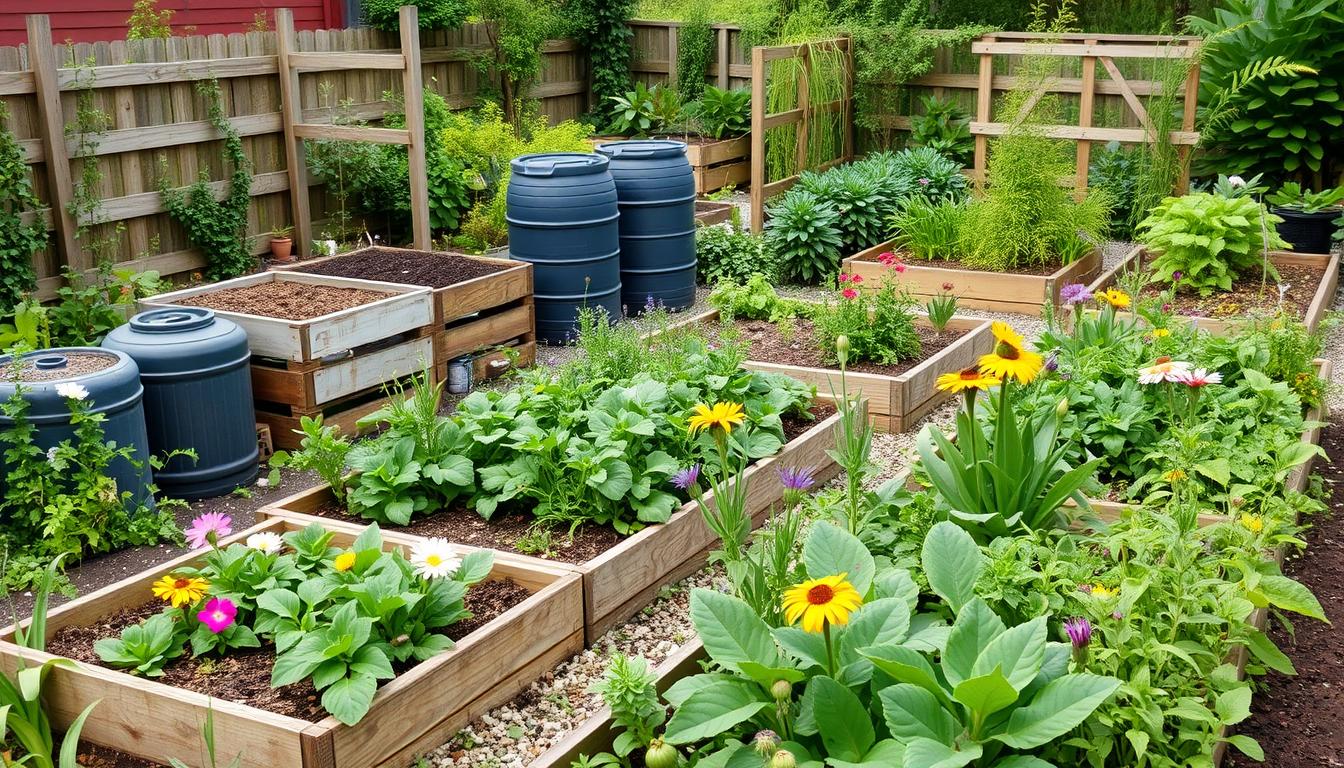I believe healthy planets start with our backyards. Using sustainable gardening is crucial today, not just a fad. It’s about choices that help our gardens, communities, and the Earth.
I’ll cover sustainable gardening’s key points here. We can all make gardens more eco-friendly. We’ll look at soil health, cutting carbon footprints, and more. Together, let’s make the future greener, one garden at a time.
Why Sustainable Gardening Matters
I care deeply about the planet, so I garden in ways that protect it. Using organic methods and less chemicals, I help keep the air, soil, and water clean. This makes our ecosystems healthier and shows how important sustainable gardening is for our world.
Connection to Environmental Health
We make a big difference in the environment by the way we garden. Sustainable practices improve our air and soil. It feels great to help fight climate change with eco-friendly gardening.
Supporting Local Ecosystems
My garden does more than just look nice; it helps local animals, too. By offering a home to different creatures and using plants from the area, I boost biodiversity. My garden is not just for show. It’s a vital part of our local nature.
My Journey into Sustainable Gardening
I began my journey into sustainable gardening with deep reflection on its roots in my life. Family traditions introduced me to the joys of connecting with nature. Over meals, my grandparents would share their gardening stories, teaching me valuable lessons.
These stories showed me the importance of caring for the earth. This understanding led me to learn more about sustainable gardening. I explored resources like “The Garden Primer” by Barbara Damrosch.
Early Influences and Education
I dove into sustainable gardening through workshops and classes. They focused on caring for the environment while gardening. I learned a lot about soil health, composting, and using native plants.
These lessons deepened my passion. They gave me the tools needed for gardening success.
First Steps in My Garden
Starting my sustainable garden was both tough and rewarding. I chose a small spot in my backyard and used what I had learned. It was a time of trying things out, learning about my local area, and seeing how gardening can be sustainable.
Through this, I understood how my actions affect the environment. Every mistake taught me something important. They stressed the importance of continuous learning in sustainable gardening.

Understanding Sustainable Gardening Practices
Exploring sustainable gardening brings us closer to helping our planet and our gardens. These practices boost soil health, help local wildlife, and save water. By doing this, we make a positive impact on the earth.
Soil Health and Organic Amendments
Healthy soil is key for a thriving garden. I use compost and mulch to feed my soil. This not only enhances soil quality but also keeps it moist. It’s a way to back up eco-friendly gardening efforts that value organic soil.
Native Plants and Biodiversity
Using native plants in the garden is a smart move. They need less water and care because they’re right at home. Plus, they make my garden look good and help local animals. It’s a step towards supporting nature and sustainable gardening goals.
Water Conservation Techniques
Conserving water is crucial, especially where water is scarce. I collect rainwater and use drip irrigation to use water wisely. These actions help in reducing our water use. It supports global efforts to garden more sustainably.
The Benefits of Growing Your Own Food
Growing my own food has totally changed how I cook and eat. I get to enjoy fresh, tasty produce by following sustainable gardening methods. This food is more nutritious than what you find in stores. It has more vitamins and minerals because I pick it when it’s fully ripe. Studies, like those from the USDA, show that homegrown produce is richer in nutrients.
Cultivating my own food also helps the planet. It cuts down on my carbon footprint. By gardening in eco-friendly ways, I reduce harmful gas emissions. I do this by not relying on big farm operations which involve a lot of transport and create waste. Growing foods means no need for long truck rides and less plastic waste from packaging.
Choosing to grow my own food is also about taking care of both my body and the Earth. It’s a powerful way to live more sustainably. It teaches me the importance of both personal health and protecting our environment.
Tools and Techniques for Sustainable Gardening
For me, the right tools can make sustainable gardening fun and efficient. Using eco-friendly gardening tools improves my gardening and supports the environment. By choosing hand tools made from sustainable materials, I reduce plastic use and ensure durability. Also, non-toxic fertilizers and natural pest methods make gardening better for our planet.
Eco-Friendly Gardening Tools
I have several favorite eco-friendly gardening tools. They are:
- Hand trowels made from recycled metals
- Compostable plant pots
- Biodegradable seedling trays
- Garden scissors with wooden handles
These tools not only make gardening easier but also match my eco-friendly values. They show that making sustainable choices can be both effective and sensible.
Effective Composting Practices
Composting is key to improving soil health. Good composting involves:
- Collecting kitchen scraps like vegetable peels and coffee grounds
- Gathering yard waste such as leaves and grass clippings
- Regularly aerating the compost pile to speed decomposition
- Keeping a good mix of green materials and brown materials
These practices help me reduce waste and produce rich compost. This compost boosts my garden’s health. By using eco-friendly tools and composting, I create a lush, eco-conscious garden.
Common Misconceptions About Sustainable Gardening
I often find myths about sustainable gardening that turn people away. Clearing up these myths makes more people want to garden sustainably.
The Myth of High Maintenance
Many think sustainable gardening needs a lot of work. But, sustainable methods often mean less upkeep. For example, native plants require less water and care.
Learning these techniques made my gardening more fun and easier to handle.
Cost Concerns and Budgeting
Some believe starting a sustainable garden is expensive. It’s not always true. By being thrifty, I made a lush garden without spending a lot.
Using compost, collecting rainwater, and exchanging seeds with friends helps save money. So, gardening sustainably can fit a small budget with smart planning.

Involving Community in Sustainable Practices
Getting the community involved is key for supporting sustainable gardening. People learn and grow together, creating a shared mission. Local gardening workshops are vital for this.
Organizing Local Gardening Workshops
Workshops teach vital gardening skills, sparking an interest in community gardening. Attendees can:
- Learn about sustainable gardening techniques
- Exchange tips on growing vegetables and flowers
- Collaborate on solving gardening challenges
This shared knowledge encourages greener habits. It inspires others to garden responsibly too.
Building Community Gardens
Community gardens also boost engagement. They provide fresh food and places for people to meet. By gardening together, communities can:
- Foster friendships and strengthen social ties
- Increase awareness regarding sustainable gardening practices
- Encourage diverse participation from all community members
Community gardens show what we can achieve when we work together. They make our environment better and strengthen our neighborhoods.
How to Advocate for Sustainable Practices
Advocating for sustainable gardening is key to helping our environment. I work with local lawmakers to push for policies that help the planet. By talking to these officials, I show how green practices can improve our surrounding nature.
Engaging with Local Legislators
Getting to know our representatives can make a big difference.
Here’s how I connect:
- Research local agricultural policies and identify gaps that sustainable gardening could fill.
- Request meetings with legislators to discuss the need for support in sustainable farming initiatives.
- Share personal experiences and success stories that highlight the benefits of these practices.
- Encourage community members to join in the advocacy efforts for greater impact.
Promoting Educational Programs
Educating others on sustainable gardening is also crucial.
We can spread the word by:
- Organizing workshops at local schools to teach students about gardening techniques.
- Partnering with community organizations to offer classes on organic gardening.
- Utilizing social media platforms to share resources and tips about sustainable gardening.

Resources for Sustainable Gardening Inspiration
Looking for inspiration in sustainable gardening is key. There are many resources to help you learn and improve your gardening. I’ll share some great books, documentaries, and online places that have taught me a lot about eco-friendly gardening.
Books and Documentaries
There are plenty of books and films that teach about sustainable gardening. They share ways to change your garden for the better and help the planet. Here are some top picks:
- The Garden Primer by Barbara Damrosch – A top choice for learning all about gardening.
- Seed Savers Exchange – A group focused on saving special seeds and increasing garden variety.
- Back to Eden – A film exploring ways to garden naturally and its positive effects on the environment.
Online Communities and Forums
Joining online groups can really boost your gardening knowledge. These places are perfect for sharing stories, getting advice, and discussing ideas. Here are some notable ones:
- Reddit’s r/sustainablegardening – A lively space for gardening advice and sharing your gardening wins.
- Facebook Groups – Search here for groups all about gardening sustainably, where members share helpful advice and resources.
- Gardening Know How – A great site for finding articles and Q&As on gardening in a sustainable way.
My Favorite Sustainable Gardening Projects
Looking back at my gardening path, I’ve been inspired by several local sustainable gardening efforts. These projects show the creativity and resourcefulness of gardeners around me. They prove the benefits of sustainable gardening and push me to try new techniques in my garden.
Highlighting Successful Local Gardens
Community gardens and gardening co-ops play a big role in spreading sustainable practices. I have seen many gardens where volunteers work together. They don’t just grow food; they also grow a community spirit. Projects like these show that with teamwork and dedication, sustainable gardening can thrive.
- Community Garden at Main Street: A vibrant space where locals grow vegetables using organic methods.
- Urban Farm Initiative: A project focused on permaculture principles that has revitalized an entire neighborhood.
- Children’s Garden Program: Engages youth in sustainable practices while educating them about food sources and the environment.
My Personal Gardening Innovations
I’m working on making my garden not just successful, but also eco-friendly. I’ve come up with some innovative, sustainable gardening methods. These techniques let me express my creativity while staying green.
- Vertical Gardening: Utilizing space creatively, I’ve introduced vertical structures that maximize sunlight and resources.
- Rainwater Harvesting: By implementing a rain barrel system, I efficiently collect water for irrigation, promoting conservation.
- Companion Planting: Experimenting with plant pairings has improved pest control and enhanced the overall health of my garden.
The Future of Sustainable Gardening
I’m really excited about the future of sustainable gardening. There are so many new trends coming up. We’re seeing smart technologies that check on plant health and vertical gardens that save space. Urban farming is another big thing. It lets people in cities grow their own food and feel closer to nature. An article in the International Journal of Agricultural Sustainability says these trends are important. They help us garden in ways that fit our changing world.
Trends to Watch
Smart gardening tools are really changing the game. They can tell you when your plants need water. This makes gardening easier and helps save water too. Then there are vertical gardens. They’re great for people who don’t have a lot of space. I want to try these new ideas in my garden.
How I Plan to Evolve My Gardening Practices
I’m planning to change the way I garden. I want to try vertical gardening to grow more in less space and keep my garden diverse. I also want to keep up with new technologies that make gardening better for the planet. By trying new things and talking about what I learn, I hope more people will start gardening this way. It’s important for the health of our planet.

